Strategic Development Report: Hospitality Industry in Australia
VerifiedAdded on 2022/09/14
|6
|1596
|14
Report
AI Summary
This report delves into the strategic development within the hospitality industry, with a specific focus on the Australian market. It begins by defining strategic development and then provides an overview of the hospitality industry, highlighting its economic significance and growth trends. The report employs Porter's Five Forces analysis to assess the industry's competitive landscape, examining factors such as competitive rivalry, barriers to entry, supplier power, buyer power, and the threat of substitutes. Subsequently, a PESTLE analysis of Australia is conducted to evaluate the macro-environmental factors influencing the industry, including political, economic, social, technological, environmental, and legal aspects. The core of the report lies in a comparative analysis of two key players: Ramada Resort (Phillip Island) and Marriott Australia. It explores their current strategies, missions, visions, and market approaches, including market development and product development strategies. The report concludes by summarizing the strategic approaches of the two companies and offering insights into the competitive dynamics of the Australian hospitality market, emphasizing the importance of innovation and differentiation for success.
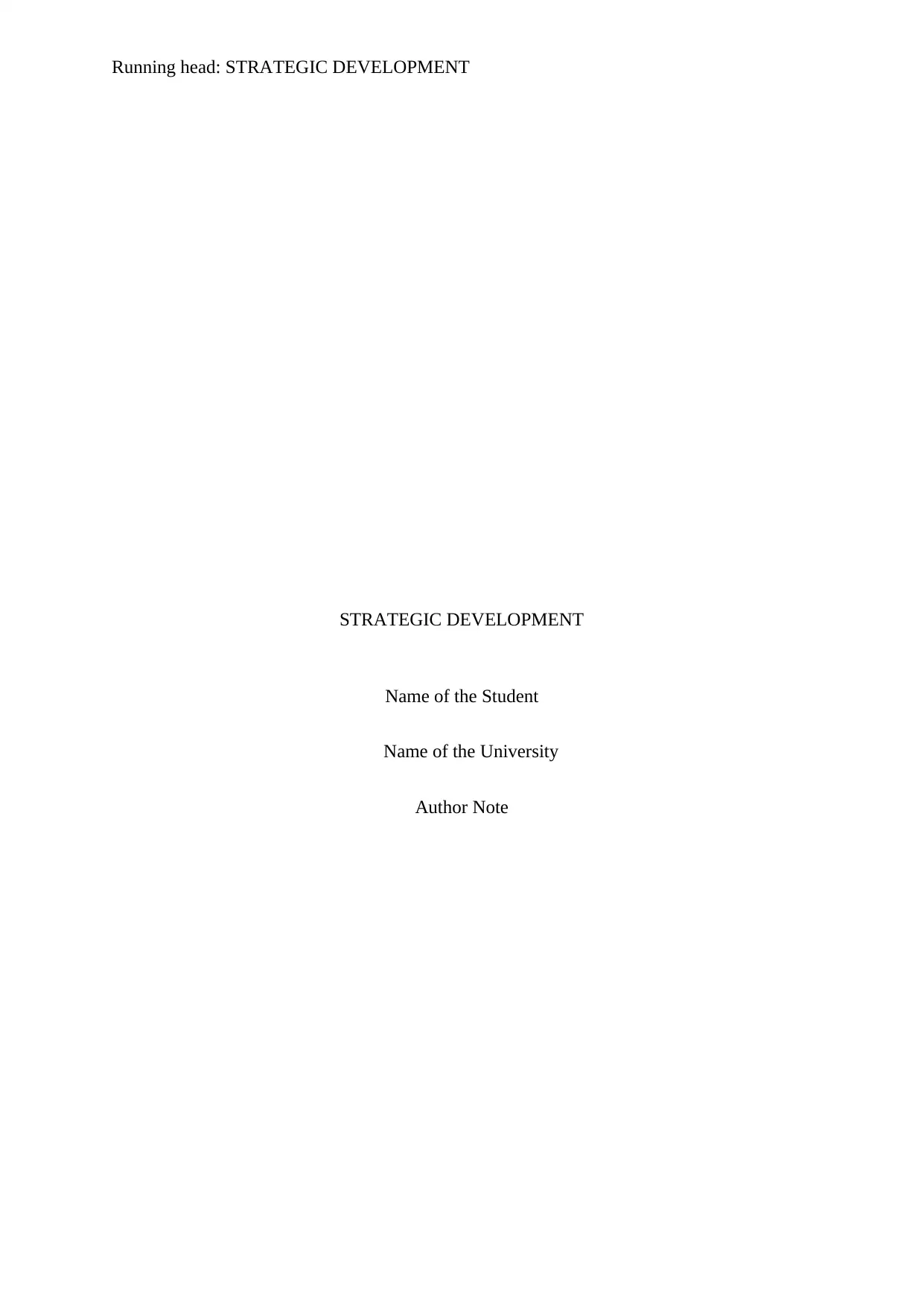
Running head: STRATEGIC DEVELOPMENT
STRATEGIC DEVELOPMENT
Name of the Student
Name of the University
Author Note
STRATEGIC DEVELOPMENT
Name of the Student
Name of the University
Author Note
Paraphrase This Document
Need a fresh take? Get an instant paraphrase of this document with our AI Paraphraser
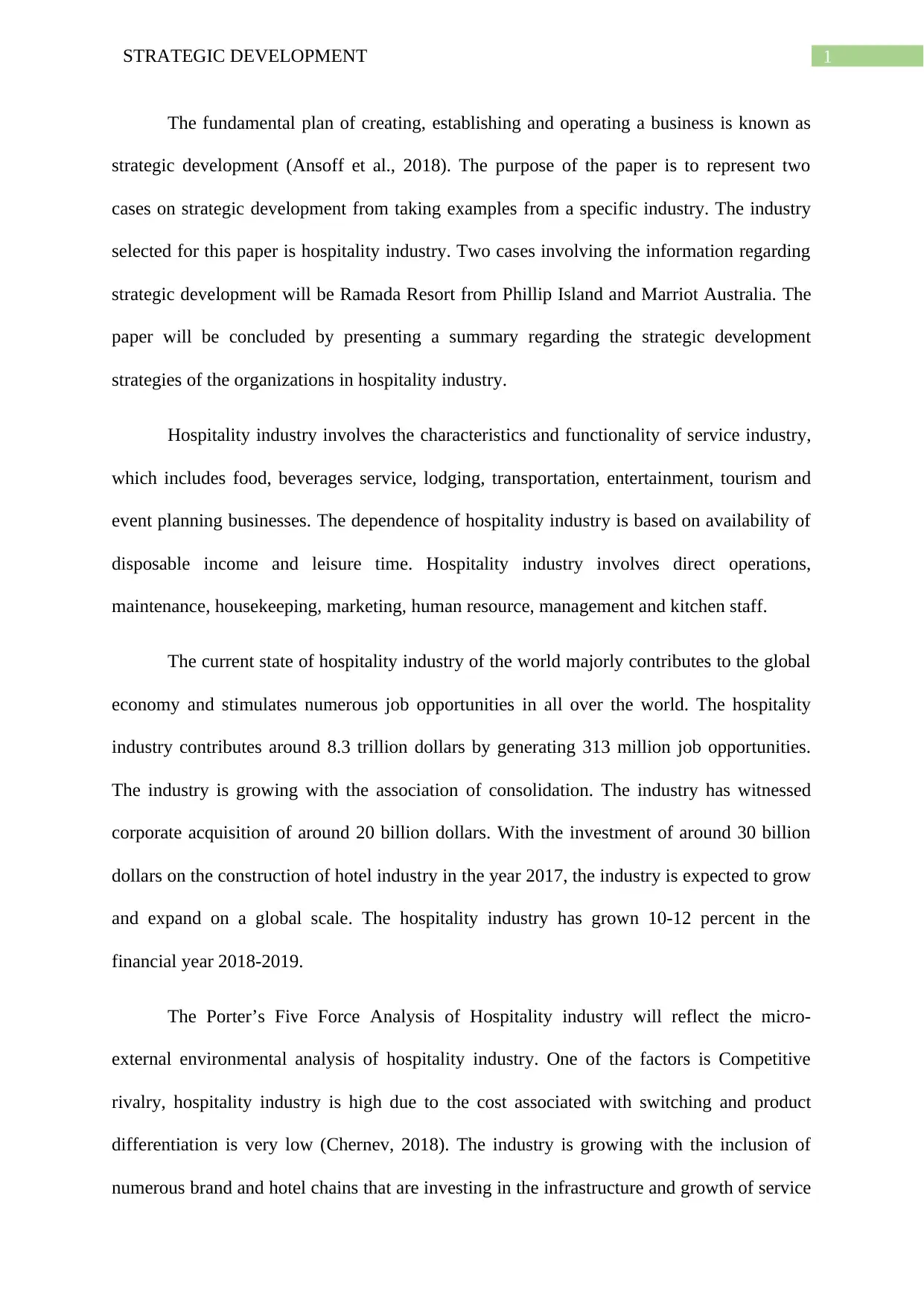
1STRATEGIC DEVELOPMENT
The fundamental plan of creating, establishing and operating a business is known as
strategic development (Ansoff et al., 2018). The purpose of the paper is to represent two
cases on strategic development from taking examples from a specific industry. The industry
selected for this paper is hospitality industry. Two cases involving the information regarding
strategic development will be Ramada Resort from Phillip Island and Marriot Australia. The
paper will be concluded by presenting a summary regarding the strategic development
strategies of the organizations in hospitality industry.
Hospitality industry involves the characteristics and functionality of service industry,
which includes food, beverages service, lodging, transportation, entertainment, tourism and
event planning businesses. The dependence of hospitality industry is based on availability of
disposable income and leisure time. Hospitality industry involves direct operations,
maintenance, housekeeping, marketing, human resource, management and kitchen staff.
The current state of hospitality industry of the world majorly contributes to the global
economy and stimulates numerous job opportunities in all over the world. The hospitality
industry contributes around 8.3 trillion dollars by generating 313 million job opportunities.
The industry is growing with the association of consolidation. The industry has witnessed
corporate acquisition of around 20 billion dollars. With the investment of around 30 billion
dollars on the construction of hotel industry in the year 2017, the industry is expected to grow
and expand on a global scale. The hospitality industry has grown 10-12 percent in the
financial year 2018-2019.
The Porter’s Five Force Analysis of Hospitality industry will reflect the micro-
external environmental analysis of hospitality industry. One of the factors is Competitive
rivalry, hospitality industry is high due to the cost associated with switching and product
differentiation is very low (Chernev, 2018). The industry is growing with the inclusion of
numerous brand and hotel chains that are investing in the infrastructure and growth of service
The fundamental plan of creating, establishing and operating a business is known as
strategic development (Ansoff et al., 2018). The purpose of the paper is to represent two
cases on strategic development from taking examples from a specific industry. The industry
selected for this paper is hospitality industry. Two cases involving the information regarding
strategic development will be Ramada Resort from Phillip Island and Marriot Australia. The
paper will be concluded by presenting a summary regarding the strategic development
strategies of the organizations in hospitality industry.
Hospitality industry involves the characteristics and functionality of service industry,
which includes food, beverages service, lodging, transportation, entertainment, tourism and
event planning businesses. The dependence of hospitality industry is based on availability of
disposable income and leisure time. Hospitality industry involves direct operations,
maintenance, housekeeping, marketing, human resource, management and kitchen staff.
The current state of hospitality industry of the world majorly contributes to the global
economy and stimulates numerous job opportunities in all over the world. The hospitality
industry contributes around 8.3 trillion dollars by generating 313 million job opportunities.
The industry is growing with the association of consolidation. The industry has witnessed
corporate acquisition of around 20 billion dollars. With the investment of around 30 billion
dollars on the construction of hotel industry in the year 2017, the industry is expected to grow
and expand on a global scale. The hospitality industry has grown 10-12 percent in the
financial year 2018-2019.
The Porter’s Five Force Analysis of Hospitality industry will reflect the micro-
external environmental analysis of hospitality industry. One of the factors is Competitive
rivalry, hospitality industry is high due to the cost associated with switching and product
differentiation is very low (Chernev, 2018). The industry is growing with the inclusion of
numerous brand and hotel chains that are investing in the infrastructure and growth of service
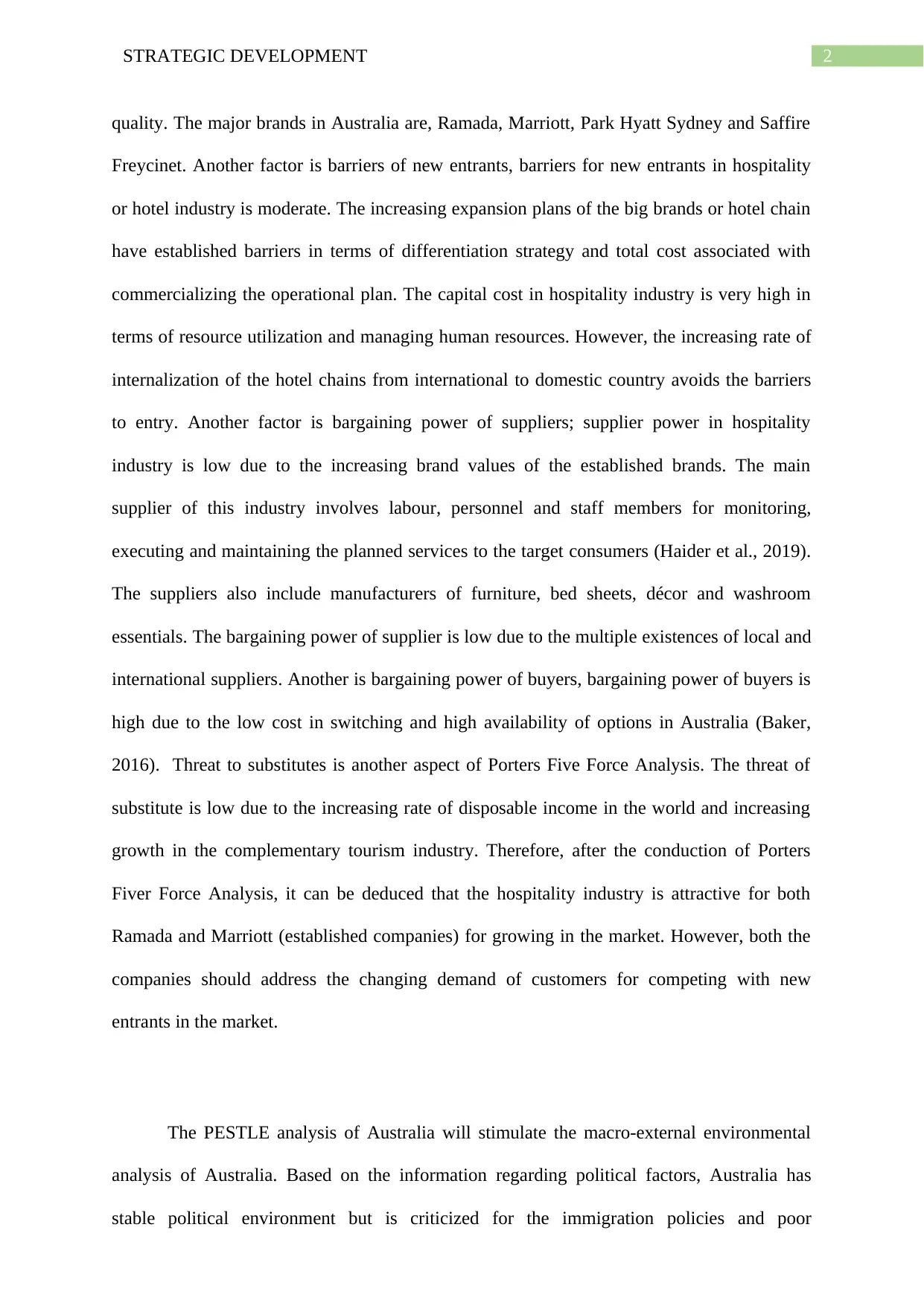
2STRATEGIC DEVELOPMENT
quality. The major brands in Australia are, Ramada, Marriott, Park Hyatt Sydney and Saffire
Freycinet. Another factor is barriers of new entrants, barriers for new entrants in hospitality
or hotel industry is moderate. The increasing expansion plans of the big brands or hotel chain
have established barriers in terms of differentiation strategy and total cost associated with
commercializing the operational plan. The capital cost in hospitality industry is very high in
terms of resource utilization and managing human resources. However, the increasing rate of
internalization of the hotel chains from international to domestic country avoids the barriers
to entry. Another factor is bargaining power of suppliers; supplier power in hospitality
industry is low due to the increasing brand values of the established brands. The main
supplier of this industry involves labour, personnel and staff members for monitoring,
executing and maintaining the planned services to the target consumers (Haider et al., 2019).
The suppliers also include manufacturers of furniture, bed sheets, décor and washroom
essentials. The bargaining power of supplier is low due to the multiple existences of local and
international suppliers. Another is bargaining power of buyers, bargaining power of buyers is
high due to the low cost in switching and high availability of options in Australia (Baker,
2016). Threat to substitutes is another aspect of Porters Five Force Analysis. The threat of
substitute is low due to the increasing rate of disposable income in the world and increasing
growth in the complementary tourism industry. Therefore, after the conduction of Porters
Fiver Force Analysis, it can be deduced that the hospitality industry is attractive for both
Ramada and Marriott (established companies) for growing in the market. However, both the
companies should address the changing demand of customers for competing with new
entrants in the market.
The PESTLE analysis of Australia will stimulate the macro-external environmental
analysis of Australia. Based on the information regarding political factors, Australia has
stable political environment but is criticized for the immigration policies and poor
quality. The major brands in Australia are, Ramada, Marriott, Park Hyatt Sydney and Saffire
Freycinet. Another factor is barriers of new entrants, barriers for new entrants in hospitality
or hotel industry is moderate. The increasing expansion plans of the big brands or hotel chain
have established barriers in terms of differentiation strategy and total cost associated with
commercializing the operational plan. The capital cost in hospitality industry is very high in
terms of resource utilization and managing human resources. However, the increasing rate of
internalization of the hotel chains from international to domestic country avoids the barriers
to entry. Another factor is bargaining power of suppliers; supplier power in hospitality
industry is low due to the increasing brand values of the established brands. The main
supplier of this industry involves labour, personnel and staff members for monitoring,
executing and maintaining the planned services to the target consumers (Haider et al., 2019).
The suppliers also include manufacturers of furniture, bed sheets, décor and washroom
essentials. The bargaining power of supplier is low due to the multiple existences of local and
international suppliers. Another is bargaining power of buyers, bargaining power of buyers is
high due to the low cost in switching and high availability of options in Australia (Baker,
2016). Threat to substitutes is another aspect of Porters Five Force Analysis. The threat of
substitute is low due to the increasing rate of disposable income in the world and increasing
growth in the complementary tourism industry. Therefore, after the conduction of Porters
Fiver Force Analysis, it can be deduced that the hospitality industry is attractive for both
Ramada and Marriott (established companies) for growing in the market. However, both the
companies should address the changing demand of customers for competing with new
entrants in the market.
The PESTLE analysis of Australia will stimulate the macro-external environmental
analysis of Australia. Based on the information regarding political factors, Australia has
stable political environment but is criticized for the immigration policies and poor
⊘ This is a preview!⊘
Do you want full access?
Subscribe today to unlock all pages.

Trusted by 1+ million students worldwide
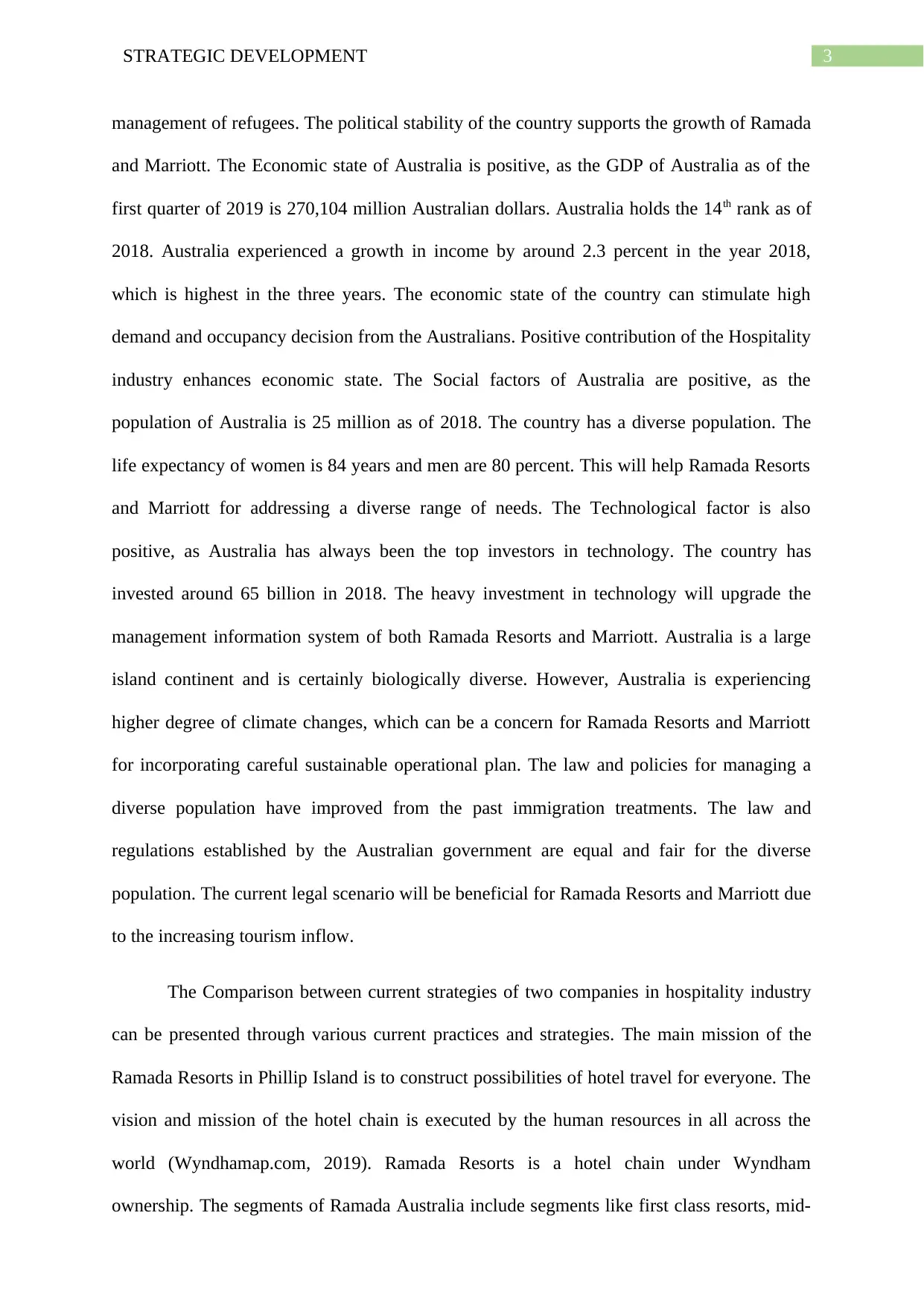
3STRATEGIC DEVELOPMENT
management of refugees. The political stability of the country supports the growth of Ramada
and Marriott. The Economic state of Australia is positive, as the GDP of Australia as of the
first quarter of 2019 is 270,104 million Australian dollars. Australia holds the 14th rank as of
2018. Australia experienced a growth in income by around 2.3 percent in the year 2018,
which is highest in the three years. The economic state of the country can stimulate high
demand and occupancy decision from the Australians. Positive contribution of the Hospitality
industry enhances economic state. The Social factors of Australia are positive, as the
population of Australia is 25 million as of 2018. The country has a diverse population. The
life expectancy of women is 84 years and men are 80 percent. This will help Ramada Resorts
and Marriott for addressing a diverse range of needs. The Technological factor is also
positive, as Australia has always been the top investors in technology. The country has
invested around 65 billion in 2018. The heavy investment in technology will upgrade the
management information system of both Ramada Resorts and Marriott. Australia is a large
island continent and is certainly biologically diverse. However, Australia is experiencing
higher degree of climate changes, which can be a concern for Ramada Resorts and Marriott
for incorporating careful sustainable operational plan. The law and policies for managing a
diverse population have improved from the past immigration treatments. The law and
regulations established by the Australian government are equal and fair for the diverse
population. The current legal scenario will be beneficial for Ramada Resorts and Marriott due
to the increasing tourism inflow.
The Comparison between current strategies of two companies in hospitality industry
can be presented through various current practices and strategies. The main mission of the
Ramada Resorts in Phillip Island is to construct possibilities of hotel travel for everyone. The
vision and mission of the hotel chain is executed by the human resources in all across the
world (Wyndhamap.com, 2019). Ramada Resorts is a hotel chain under Wyndham
ownership. The segments of Ramada Australia include segments like first class resorts, mid-
management of refugees. The political stability of the country supports the growth of Ramada
and Marriott. The Economic state of Australia is positive, as the GDP of Australia as of the
first quarter of 2019 is 270,104 million Australian dollars. Australia holds the 14th rank as of
2018. Australia experienced a growth in income by around 2.3 percent in the year 2018,
which is highest in the three years. The economic state of the country can stimulate high
demand and occupancy decision from the Australians. Positive contribution of the Hospitality
industry enhances economic state. The Social factors of Australia are positive, as the
population of Australia is 25 million as of 2018. The country has a diverse population. The
life expectancy of women is 84 years and men are 80 percent. This will help Ramada Resorts
and Marriott for addressing a diverse range of needs. The Technological factor is also
positive, as Australia has always been the top investors in technology. The country has
invested around 65 billion in 2018. The heavy investment in technology will upgrade the
management information system of both Ramada Resorts and Marriott. Australia is a large
island continent and is certainly biologically diverse. However, Australia is experiencing
higher degree of climate changes, which can be a concern for Ramada Resorts and Marriott
for incorporating careful sustainable operational plan. The law and policies for managing a
diverse population have improved from the past immigration treatments. The law and
regulations established by the Australian government are equal and fair for the diverse
population. The current legal scenario will be beneficial for Ramada Resorts and Marriott due
to the increasing tourism inflow.
The Comparison between current strategies of two companies in hospitality industry
can be presented through various current practices and strategies. The main mission of the
Ramada Resorts in Phillip Island is to construct possibilities of hotel travel for everyone. The
vision and mission of the hotel chain is executed by the human resources in all across the
world (Wyndhamap.com, 2019). Ramada Resorts is a hotel chain under Wyndham
ownership. The segments of Ramada Australia include segments like first class resorts, mid-
Paraphrase This Document
Need a fresh take? Get an instant paraphrase of this document with our AI Paraphraser
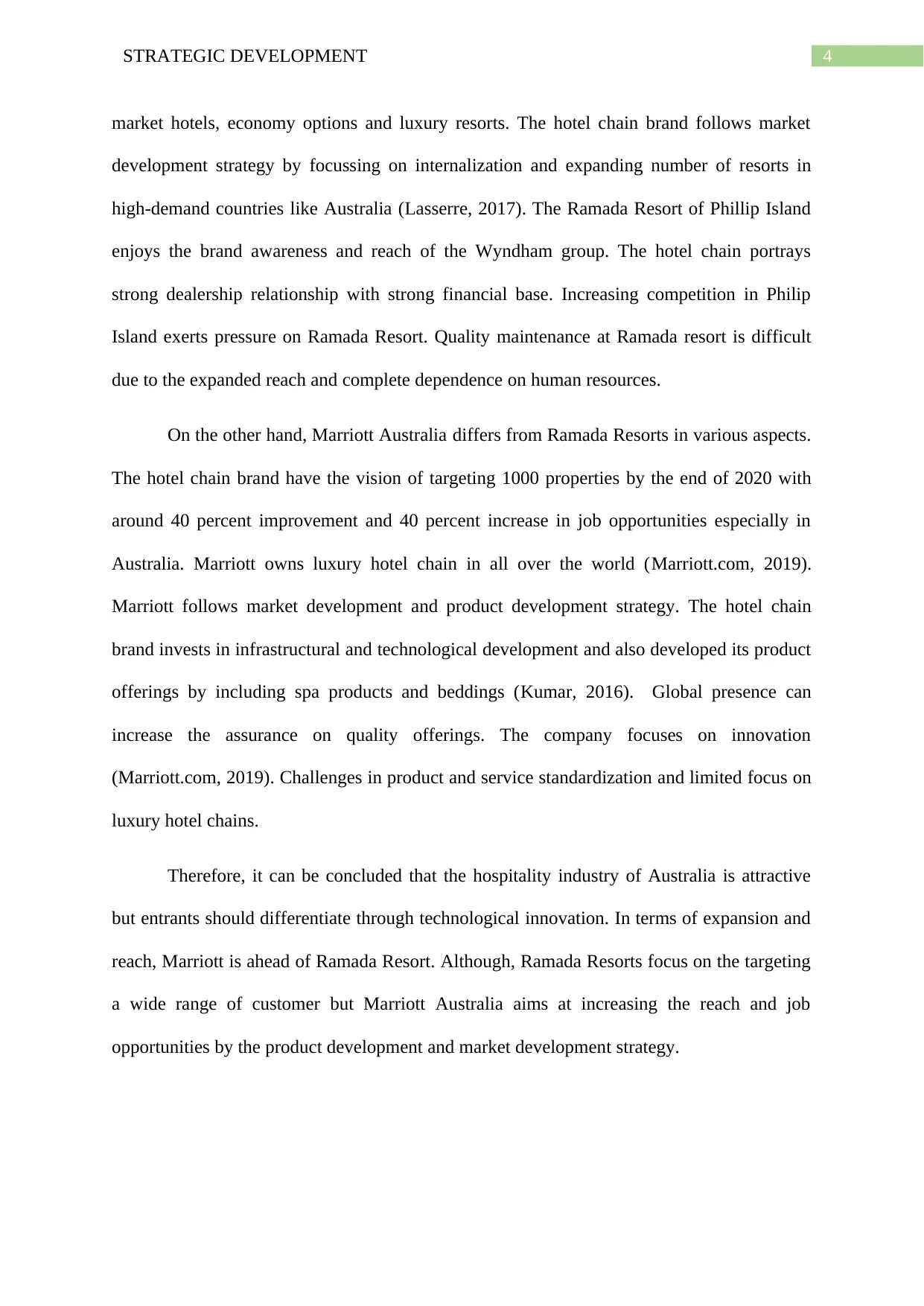
4STRATEGIC DEVELOPMENT
market hotels, economy options and luxury resorts. The hotel chain brand follows market
development strategy by focussing on internalization and expanding number of resorts in
high-demand countries like Australia (Lasserre, 2017). The Ramada Resort of Phillip Island
enjoys the brand awareness and reach of the Wyndham group. The hotel chain portrays
strong dealership relationship with strong financial base. Increasing competition in Philip
Island exerts pressure on Ramada Resort. Quality maintenance at Ramada resort is difficult
due to the expanded reach and complete dependence on human resources.
On the other hand, Marriott Australia differs from Ramada Resorts in various aspects.
The hotel chain brand have the vision of targeting 1000 properties by the end of 2020 with
around 40 percent improvement and 40 percent increase in job opportunities especially in
Australia. Marriott owns luxury hotel chain in all over the world (Marriott.com, 2019).
Marriott follows market development and product development strategy. The hotel chain
brand invests in infrastructural and technological development and also developed its product
offerings by including spa products and beddings (Kumar, 2016). Global presence can
increase the assurance on quality offerings. The company focuses on innovation
(Marriott.com, 2019). Challenges in product and service standardization and limited focus on
luxury hotel chains.
Therefore, it can be concluded that the hospitality industry of Australia is attractive
but entrants should differentiate through technological innovation. In terms of expansion and
reach, Marriott is ahead of Ramada Resort. Although, Ramada Resorts focus on the targeting
a wide range of customer but Marriott Australia aims at increasing the reach and job
opportunities by the product development and market development strategy.
market hotels, economy options and luxury resorts. The hotel chain brand follows market
development strategy by focussing on internalization and expanding number of resorts in
high-demand countries like Australia (Lasserre, 2017). The Ramada Resort of Phillip Island
enjoys the brand awareness and reach of the Wyndham group. The hotel chain portrays
strong dealership relationship with strong financial base. Increasing competition in Philip
Island exerts pressure on Ramada Resort. Quality maintenance at Ramada resort is difficult
due to the expanded reach and complete dependence on human resources.
On the other hand, Marriott Australia differs from Ramada Resorts in various aspects.
The hotel chain brand have the vision of targeting 1000 properties by the end of 2020 with
around 40 percent improvement and 40 percent increase in job opportunities especially in
Australia. Marriott owns luxury hotel chain in all over the world (Marriott.com, 2019).
Marriott follows market development and product development strategy. The hotel chain
brand invests in infrastructural and technological development and also developed its product
offerings by including spa products and beddings (Kumar, 2016). Global presence can
increase the assurance on quality offerings. The company focuses on innovation
(Marriott.com, 2019). Challenges in product and service standardization and limited focus on
luxury hotel chains.
Therefore, it can be concluded that the hospitality industry of Australia is attractive
but entrants should differentiate through technological innovation. In terms of expansion and
reach, Marriott is ahead of Ramada Resort. Although, Ramada Resorts focus on the targeting
a wide range of customer but Marriott Australia aims at increasing the reach and job
opportunities by the product development and market development strategy.
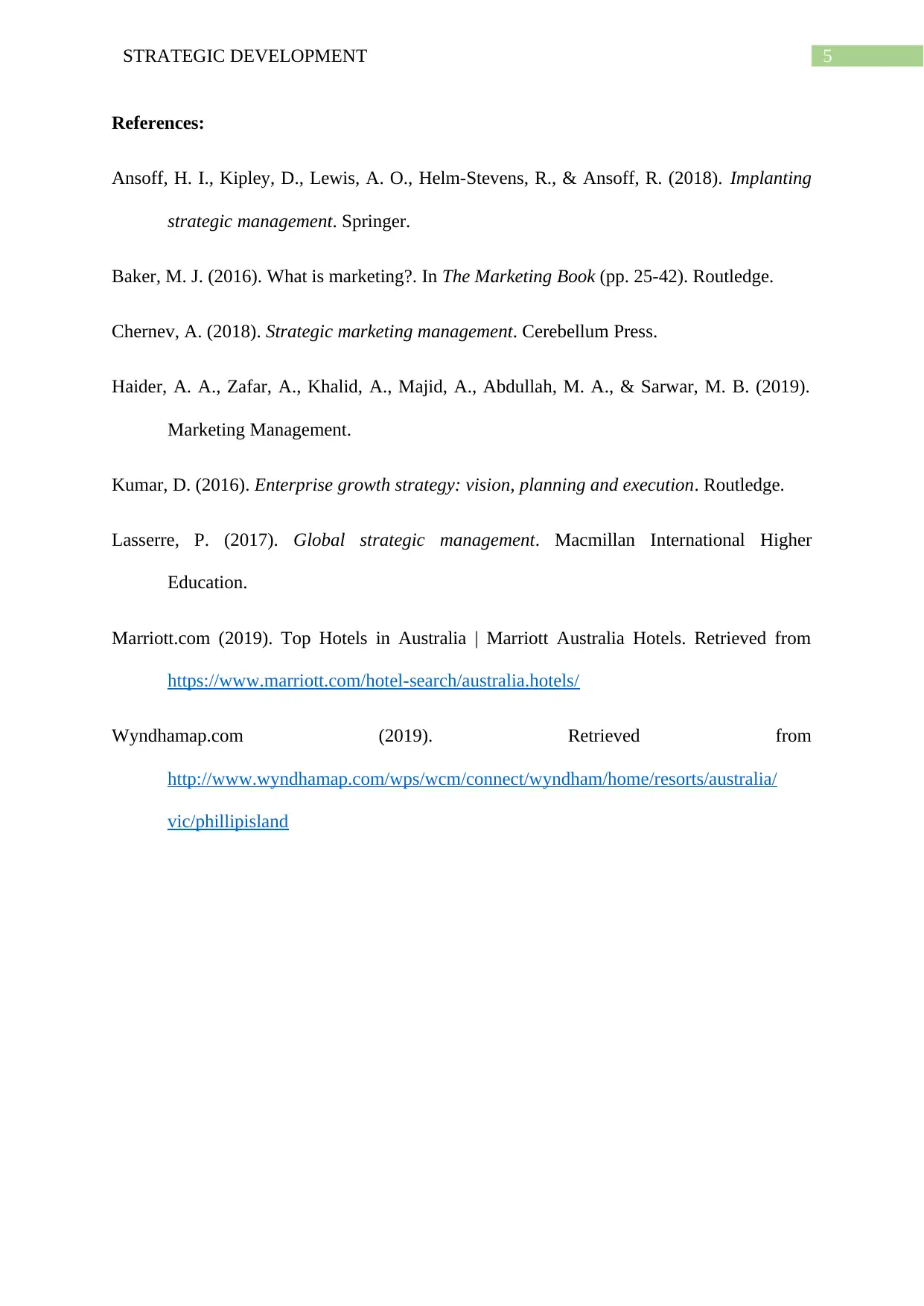
5STRATEGIC DEVELOPMENT
References:
Ansoff, H. I., Kipley, D., Lewis, A. O., Helm-Stevens, R., & Ansoff, R. (2018). Implanting
strategic management. Springer.
Baker, M. J. (2016). What is marketing?. In The Marketing Book (pp. 25-42). Routledge.
Chernev, A. (2018). Strategic marketing management. Cerebellum Press.
Haider, A. A., Zafar, A., Khalid, A., Majid, A., Abdullah, M. A., & Sarwar, M. B. (2019).
Marketing Management.
Kumar, D. (2016). Enterprise growth strategy: vision, planning and execution. Routledge.
Lasserre, P. (2017). Global strategic management. Macmillan International Higher
Education.
Marriott.com (2019). Top Hotels in Australia | Marriott Australia Hotels. Retrieved from
https://www.marriott.com/hotel-search/australia.hotels/
Wyndhamap.com (2019). Retrieved from
http://www.wyndhamap.com/wps/wcm/connect/wyndham/home/resorts/australia/
vic/phillipisland
References:
Ansoff, H. I., Kipley, D., Lewis, A. O., Helm-Stevens, R., & Ansoff, R. (2018). Implanting
strategic management. Springer.
Baker, M. J. (2016). What is marketing?. In The Marketing Book (pp. 25-42). Routledge.
Chernev, A. (2018). Strategic marketing management. Cerebellum Press.
Haider, A. A., Zafar, A., Khalid, A., Majid, A., Abdullah, M. A., & Sarwar, M. B. (2019).
Marketing Management.
Kumar, D. (2016). Enterprise growth strategy: vision, planning and execution. Routledge.
Lasserre, P. (2017). Global strategic management. Macmillan International Higher
Education.
Marriott.com (2019). Top Hotels in Australia | Marriott Australia Hotels. Retrieved from
https://www.marriott.com/hotel-search/australia.hotels/
Wyndhamap.com (2019). Retrieved from
http://www.wyndhamap.com/wps/wcm/connect/wyndham/home/resorts/australia/
vic/phillipisland
⊘ This is a preview!⊘
Do you want full access?
Subscribe today to unlock all pages.

Trusted by 1+ million students worldwide
1 out of 6
Related Documents
Your All-in-One AI-Powered Toolkit for Academic Success.
+13062052269
info@desklib.com
Available 24*7 on WhatsApp / Email
![[object Object]](/_next/static/media/star-bottom.7253800d.svg)
Unlock your academic potential
Copyright © 2020–2025 A2Z Services. All Rights Reserved. Developed and managed by ZUCOL.





